While anthracnose has been a very minor problem on Central Coast strawberry up to now, this disease is known to be most severe when there are winter and spring rains. In late 2015 and early 2016, anthracnose cases have been a concern for some growers in southern California. Therefore a brief review of anthracnose would be appropriate and is presented here.
Symptoms: The anthracnose pathogen is rather unique in that this fungus can infect virtually all parts of the strawberry plant, though some infections are more important than others. Most symptoms on above-ground parts of plants consist of dark, elongated lesions. If warm, wet field conditions are present, such lesions will contain orange masses of the pathogen's spores. For below-ground parts, symptoms consist of decayed, darkened roots, discoloration of the internal crown tissue, and wilting and collapsing plants; therefore, the root and crown phases of anthracnose will closely resemble symptoms caused by Phytophthora and other soilborne pathogens. Table 1 lists the major symptoms on strawberry.
Table 1. Anthracnose symptoms and signs on strawberry
|
Strawberry tissue |
Symptoms |
Orange spore masses?
|
|
root |
discolored, rotted roots, causing leaves to wilt |
no |
|
crown |
discolored internal crown, causing leaves to wilt |
no |
|
leaf petiole |
dark brown, elongated lesions |
yes |
|
leaf blade |
gray to brown spots |
yes |
|
runner |
dark brown, elongated lesions |
yes |
|
flower peduncle (stem) |
dark brown, elongated lesions |
yes |
|
flower |
discolored tissue, causing flower to shrivel |
sometimes |
|
fruit |
brown, oval to round, firm, dry sunken spots |
yes |
Pathogen: Anthracnose on strawberry in California is primarily caused by Colletotrichum acutatum, though strawberry is also host to additional Colletotrichum species. C. acutatum is found worldwide on strawberry and many other crop and weed hosts. Some of these other hosts include the following: almond, celery, delphinium, pepper, pine tree, tomato, walnut, zinnia, chickweed, fiddleneck, vetch. It is unclear to what extent C. acutatum from non-strawberry hosts can infect and cause significant damage to strawberry. For example, researchers have found that strawberry isolates of C. acutatum are more aggressive and damaging to strawberry than isolates from other hosts. Therefore, C. acutatum is likely composed of diverse strains or sub-types that have some degree of host specificity or preference.
Disease Cycle: Colletotrichum acutatum is not a true soil inhabitant and cannot survive in the soil indefinitely. Studies show that this pathogen, under California conditions, can remain viable in the soil for about 9 months without a strawberry host. Based on this limited survival capability and the pattern and sporadic distribution of disease when it does develop, disease occurrence in fumigated fields is primarily due to infested or diseased strawberry transplants. The disease is favored by moderate temperatures (60 to 85 degrees F) and wet, humid weather. The development and spread of spores is strongly dependent on sprinkler irrigation and rain. The spores form in a sticky matrix and will only spread through physical contact (such as from passing equipment that brushes against the lesions) or splashing water. Therefore, anthracnose disease on strawberry fruit is very rare unless rains occur during the fruit production season.
Pre-plant control measures: Pre-plant applied soil fumigants likely will reduce most of any remaining inoculum in the soil. However, information is limited on how well non-methyl bromide containing treatments reduce soilborne inoculum. Hot water treatment of transplants can reduce the level of anthracnose. Prior to planting, dipping transplants in fungicides (such as Abound and Switch) can also reduce anthracnose. Such treatments need to be done carefully; damage has occurred to transplants dipped in Switch but not immediately planted. However, plant injury was not observed in a Ventura County experiment in which plants were dipped for 2-3 minutes in Switch (5 oz/100 gal) and then planted within 30 minutes. If considering plant dips, consult with fungicide product representatives and UC extension personnel.
Post-plant control measures: Avoid the use of overhead sprinklers. During the production growing season, if rainy weather occurs and there are concerns with or detections of anthracnose, foliar sprays are warranted. Captan, Abound, and Switch are registered and are effective in reducing disease. Note that these are protectant materials only and need to be applied prior to infection. If foliar lesions are abundant, keep in mind that passing equipment can spread spores to previously uninfected plants and blocks. If feasible, remove diseased fruit and collapsing or dead plants since these plant parts are sources of secondary inoculum.
In most cases, accurate identification of anthracnose requires laboratory analysis and testing. Before using any fungicides, check with your local Agricultural Commissioner's Office and consult product labels for current status on registration, restrictions, and use. For additional information on anthracnose and other strawberry diseases, consult the UC IPM Pest Management Guidelines:
http://ucipm.ucdavis.edu/PMG/r734101011.html
(English and Spanish versions are available).
Attached Images:
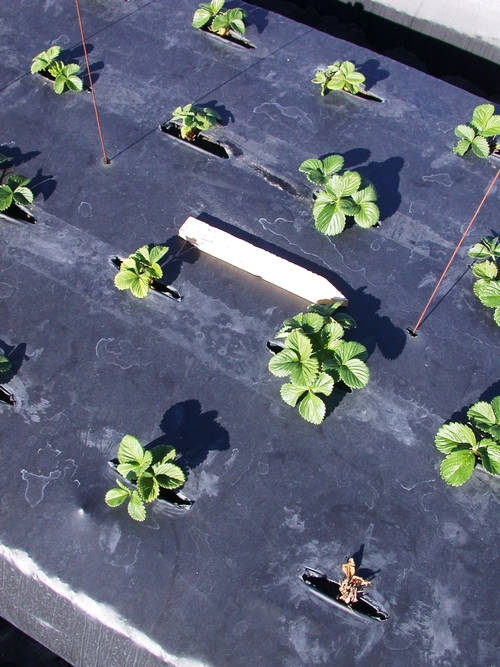
Poor growth of C. acutatum inoculated plants with some decline and mortality 6 wks after planting. Photo Oleg Daugovish, UCCE.
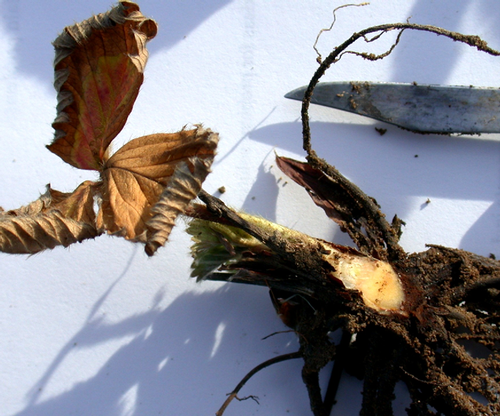
Early season die-back on C. acutatum infected strawberry. Photo Oleg Daugovish, UCCE.
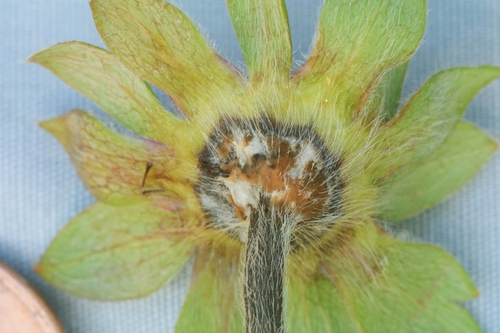
Strawberry blossom infected with C. acutatum. Photo, Steven Koike, UCCE.

Anthracnose lesion on stem of strawberry. Photo Steven Koike, UCCE.
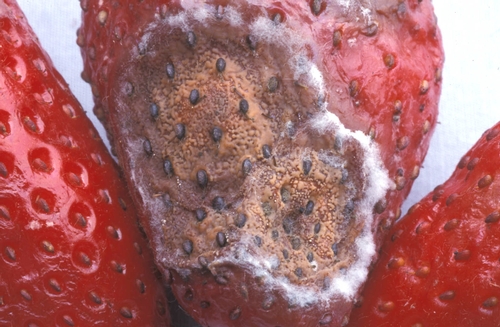
Advanced anthracnose lesion on strawberry fruit. Photo Steven Koike, UCCE.
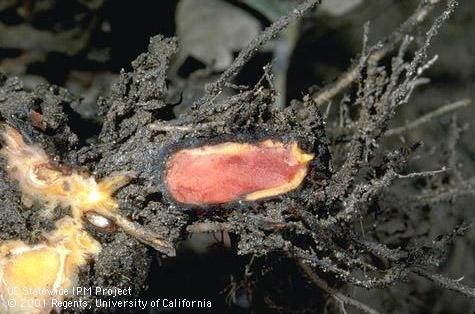
Discolored crown of strawberry caused by C. acutatum. Photo UC IPM.
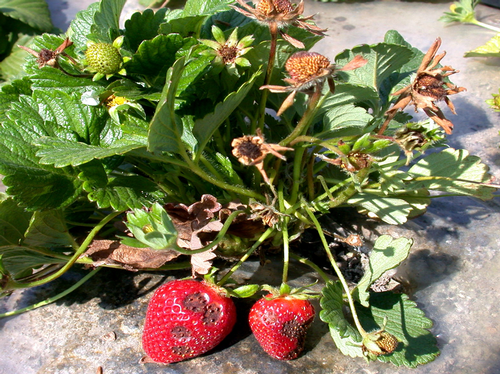
Late-season symptoms on C. acutatum infected strawberry. Photo Oleg Daugovish, UCCE.